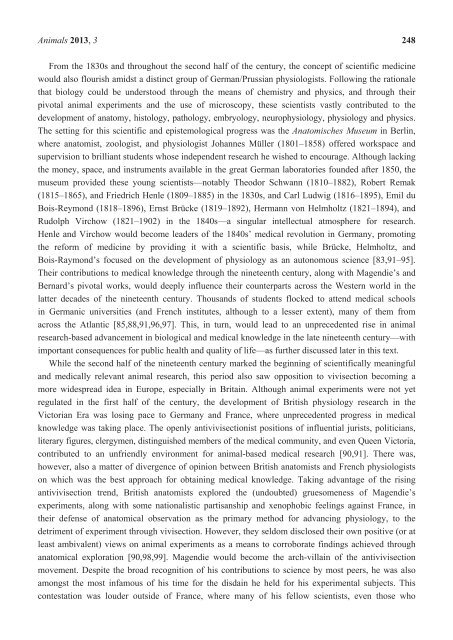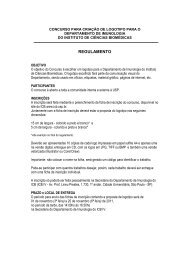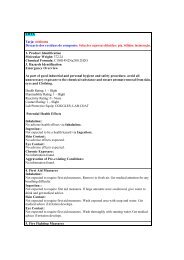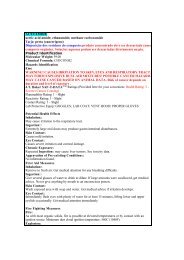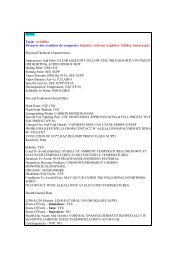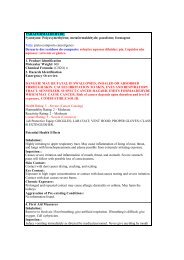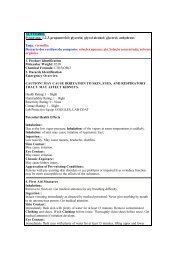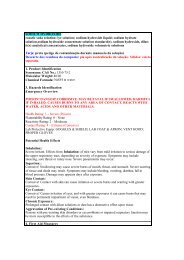Animal Experiments in Biomedical Research: A ... - MDPI.com
Animal Experiments in Biomedical Research: A ... - MDPI.com
Animal Experiments in Biomedical Research: A ... - MDPI.com
You also want an ePaper? Increase the reach of your titles
YUMPU automatically turns print PDFs into web optimized ePapers that Google loves.
<strong>Animal</strong>s 2013, 3 248From the 1830s and throughout the second half of the century, the concept of scientific medic<strong>in</strong>ewould also flourish amidst a dist<strong>in</strong>ct group of German/Prussian physiologists. Follow<strong>in</strong>g the rationalethat biology could be understood through the means of chemistry and physics, and through theirpivotal animal experiments and the use of microscopy, these scientists vastly contributed to thedevelopment of anatomy, histology, pathology, embryology, neurophysiology, physiology and physics.The sett<strong>in</strong>g for this scientific and epistemological progress was the Anatomisches Museum <strong>in</strong> Berl<strong>in</strong>,where anatomist, zoologist, and physiologist Johannes Müller (1801–1858) offered workspace andsupervision to brilliant students whose <strong>in</strong>dependent research he wished to encourage. Although lack<strong>in</strong>gthe money, space, and <strong>in</strong>struments available <strong>in</strong> the great German laboratories founded after 1850, themuseum provided these young scientists—notably Theodor Schwann (1810–1882), Robert Remak(1815–1865), and Friedrich Henle (1809–1885) <strong>in</strong> the 1830s, and Carl Ludwig (1816–1895), Emil duBois-Reymond (1818–1896), Ernst Brücke (1819–1892), Hermann von Helmholtz (1821–1894), andRudolph Virchow (1821–1902) <strong>in</strong> the 1840s—a s<strong>in</strong>gular <strong>in</strong>tellectual atmosphere for research.Henle and Virchow would be<strong>com</strong>e leaders of the 1840s’ medical revolution <strong>in</strong> Germany, promot<strong>in</strong>gthe reform of medic<strong>in</strong>e by provid<strong>in</strong>g it with a scientific basis, while Brücke, Helmholtz, andBois-Raymond’s focused on the development of physiology as an autonomous science [83,91–95].Their contributions to medical knowledge through the n<strong>in</strong>eteenth century, along with Magendie’s andBernard’s pivotal works, would deeply <strong>in</strong>fluence their counterparts across the Western world <strong>in</strong> thelatter decades of the n<strong>in</strong>eteenth century. Thousands of students flocked to attend medical schools<strong>in</strong> Germanic universities (and French <strong>in</strong>stitutes, although to a lesser extent), many of them fromacross the Atlantic [85,88,91,96,97]. This, <strong>in</strong> turn, would lead to an unprecedented rise <strong>in</strong> animalresearch-based advancement <strong>in</strong> biological and medical knowledge <strong>in</strong> the late n<strong>in</strong>eteenth century—withimportant consequences for public health and quality of life—as further discussed later <strong>in</strong> this text.While the second half of the n<strong>in</strong>eteenth century marked the beg<strong>in</strong>n<strong>in</strong>g of scientifically mean<strong>in</strong>gfuland medically relevant animal research, this period also saw opposition to vivisection be<strong>com</strong><strong>in</strong>g amore widespread idea <strong>in</strong> Europe, especially <strong>in</strong> Brita<strong>in</strong>. Although animal experiments were not yetregulated <strong>in</strong> the first half of the century, the development of British physiology research <strong>in</strong> theVictorian Era was los<strong>in</strong>g pace to Germany and France, where unprecedented progress <strong>in</strong> medicalknowledge was tak<strong>in</strong>g place. The openly antivivisectionist positions of <strong>in</strong>fluential jurists, politicians,literary figures, clergymen, dist<strong>in</strong>guished members of the medical <strong>com</strong>munity, and even Queen Victoria,contributed to an unfriendly environment for animal-based medical research [90,91]. There was,however, also a matter of divergence of op<strong>in</strong>ion between British anatomists and French physiologistson which was the best approach for obta<strong>in</strong><strong>in</strong>g medical knowledge. Tak<strong>in</strong>g advantage of the ris<strong>in</strong>gantivivisection trend, British anatomists explored the (undoubted) gruesomeness of Magendie’sexperiments, along with some nationalistic partisanship and xenophobic feel<strong>in</strong>gs aga<strong>in</strong>st France, <strong>in</strong>their defense of anatomical observation as the primary method for advanc<strong>in</strong>g physiology, to thedetriment of experiment through vivisection. However, they seldom disclosed their own positive (or atleast ambivalent) views on animal experiments as a means to corroborate f<strong>in</strong>d<strong>in</strong>gs achieved throughanatomical exploration [90,98,99]. Magendie would be<strong>com</strong>e the arch-villa<strong>in</strong> of the antivivisectionmovement. Despite the broad recognition of his contributions to science by most peers, he was alsoamongst the most <strong>in</strong>famous of his time for the disda<strong>in</strong> he held for his experimental subjects. Thiscontestation was louder outside of France, where many of his fellow scientists, even those who


